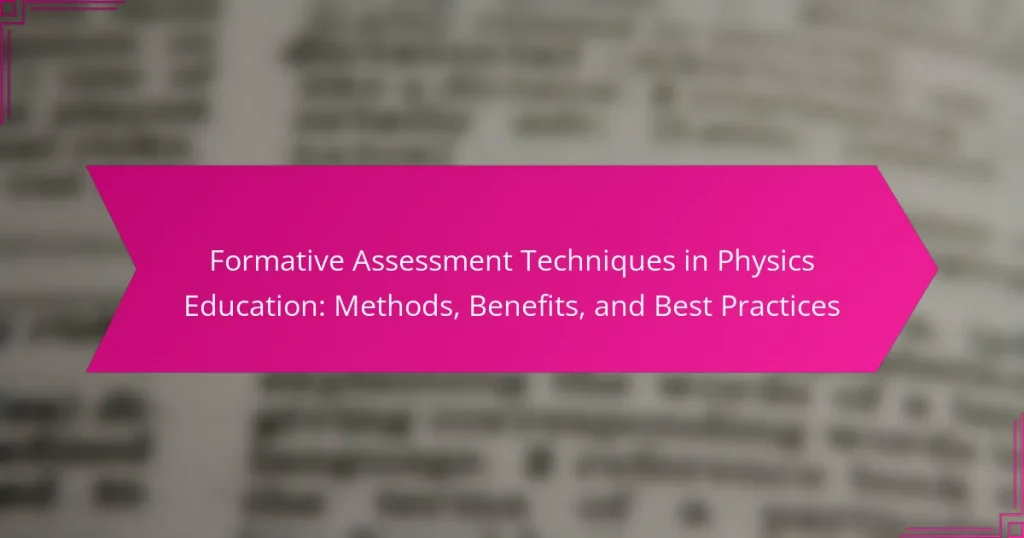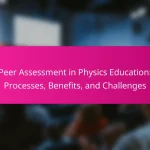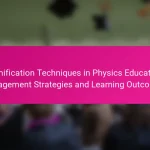Formative assessment techniques in physics education are essential strategies designed to evaluate student understanding throughout the learning process. These techniques, which include quizzes, peer assessments, and concept maps, provide immediate feedback that helps identify student challenges and enhances learning outcomes. Key practices such as think-pair-share and interactive simulations promote collaboration and clarify complex concepts. Effective formative assessment requires clear learning objectives, continuous data collection, and timely, actionable feedback, all of which contribute to improved student engagement and achievement in physics. Ongoing reflection and adaptation of assessment methods, along with professional development and technology integration, further enhance the effectiveness of these techniques.
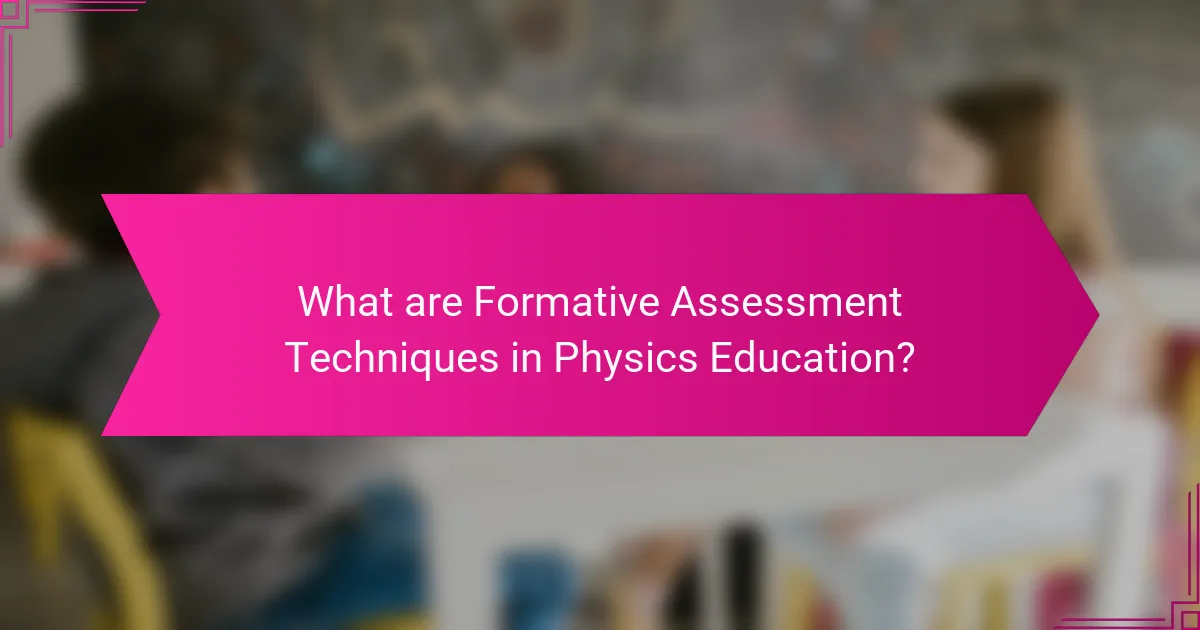
What are Formative Assessment Techniques in Physics Education?
Formative assessment techniques in physics education are strategies used to evaluate student understanding during the learning process. These techniques include quizzes, peer assessments, and concept maps. They provide immediate feedback to both students and instructors. This feedback helps identify areas where students struggle. Techniques like think-pair-share encourage collaboration and discussion among students. Additionally, interactive simulations can illustrate complex physics concepts. Research shows that formative assessments improve student engagement and learning outcomes. Techniques are essential for adapting instruction to meet student needs effectively.
How do formative assessments differ from summative assessments in physics education?
Formative assessments are ongoing evaluations used to monitor student learning in physics education. They provide real-time feedback to both students and educators. This feedback helps identify areas needing improvement during the learning process. Examples include quizzes, class discussions, and homework assignments.
In contrast, summative assessments evaluate student learning at the end of an instructional unit. They measure the extent of learning and typically contribute to final grades. Common forms include final exams, standardized tests, and major projects.
The key difference lies in timing and purpose. Formative assessments aim to enhance learning as it occurs. Summative assessments aim to measure and summarize learning outcomes after instruction. This distinction is crucial in tailoring teaching strategies to improve student understanding in physics.
What are the key characteristics of formative assessments?
Formative assessments are tools used to evaluate student learning during the instructional process. They provide ongoing feedback to both teachers and students. These assessments are typically low stakes, meaning they do not heavily impact final grades. They are designed to identify learning gaps and areas needing improvement. Formative assessments can take various forms, including quizzes, discussions, and observational assessments. They are often used to adjust teaching strategies in real-time. Research indicates that formative assessments can significantly enhance student engagement and understanding. For example, a study by Black and Wiliam (1998) found that formative assessment practices lead to improved learning outcomes across various subjects.
Why is formative assessment important in the learning process?
Formative assessment is important in the learning process because it provides ongoing feedback to both students and educators. This feedback helps identify areas where students struggle and where they excel. It allows for adjustments in teaching strategies to meet learners’ needs effectively. Research shows that formative assessment can significantly enhance student learning outcomes. For instance, a study by Black and Wiliam (1998) found that formative assessment practices can lead to a 30% increase in student performance. Thus, formative assessment is a critical tool for improving educational effectiveness.
What methods are commonly used in formative assessment for physics education?
Common methods used in formative assessment for physics education include quizzes, peer assessments, and concept maps. Quizzes provide immediate feedback on student understanding. Peer assessments encourage collaboration and critical thinking among students. Concept maps help visualize relationships between physics concepts. These methods allow educators to gauge student comprehension and adjust instruction accordingly. Research indicates that formative assessments can significantly enhance student learning outcomes in physics. For instance, a study by Black and Wiliam (1998) found that effective formative assessment practices lead to improved academic performance.
How can quizzes and polls be effectively utilized in the classroom?
Quizzes and polls can be effectively utilized in the classroom by enhancing student engagement and providing immediate feedback. They allow educators to assess understanding in real-time. Quizzes can be used to reinforce key concepts and measure retention. Polls can gauge student opinions and stimulate discussion. Research shows that active participation improves learning outcomes. For example, a study by Freeman et al. (2014) demonstrated that active learning strategies, including quizzes, significantly increase student performance in STEM subjects. Implementing these tools regularly can create a dynamic learning environment.
What role does peer assessment play in physics education?
Peer assessment plays a significant role in physics education by promoting collaborative learning. It encourages students to engage critically with their peers’ work. This process helps students develop a deeper understanding of physics concepts. Additionally, peer assessment fosters communication skills among students. Research shows that students often provide valuable feedback that enhances learning. A study by Topping (1998) indicates that peer assessment can improve academic performance. Overall, it supports a more interactive and reflective learning environment in physics classes.
How can concept maps enhance understanding in physics?
Concept maps enhance understanding in physics by visually organizing information. They illustrate relationships between concepts, making complex ideas more accessible. By connecting different physics topics, learners can see how they interrelate. This visualization aids memory retention and comprehension. Research indicates that students using concept maps perform better in assessments. A study by Novak and Gowin showed that concept mapping improves critical thinking skills. Overall, concept maps serve as effective tools in physics education.
What are the benefits of implementing formative assessment techniques?
Implementing formative assessment techniques enhances student learning and engagement. These techniques provide ongoing feedback, allowing educators to identify student understanding in real-time. This immediate feedback helps tailor instruction to meet individual learning needs. Formative assessments also encourage active participation, fostering a collaborative learning environment. Research indicates that students who receive regular formative assessments show improved academic performance. For example, a study by Black and Wiliam (1998) found that formative assessment can lead to significant gains in student achievement across various subjects.
How do formative assessments improve student engagement in physics?
Formative assessments enhance student engagement in physics by providing ongoing feedback and promoting active learning. These assessments allow students to identify their strengths and weaknesses in real-time. Engaged students are more likely to participate in discussions and collaborative activities. According to a study by Black and Wiliam (1998), formative assessment can lead to a significant increase in student achievement. The study found that effective feedback helps students understand their learning processes better. Additionally, formative assessments encourage a growth mindset, motivating students to improve continuously. Engaging students in self-assessment fosters ownership of their learning. Overall, formative assessments create a more interactive and responsive learning environment in physics.
What impact do formative assessments have on student learning outcomes?
Formative assessments significantly enhance student learning outcomes. They provide ongoing feedback that helps students identify their strengths and weaknesses. This feedback allows for timely interventions and adjustments to learning strategies. Research indicates that students who engage in formative assessments demonstrate higher academic achievement. A study by Black and Wiliam (1998) found that formative assessment can lead to an average increase of 0.7 standard deviations in student performance. This improvement is attributed to increased student engagement and motivation. Moreover, formative assessments promote a deeper understanding of the material. They encourage students to take ownership of their learning process. Overall, formative assessments play a crucial role in improving educational outcomes.

What best practices should educators follow for effective formative assessment?
Effective formative assessment involves continuous feedback and adaptation to improve student learning. Educators should establish clear learning objectives. These objectives guide assessment and instruction. Regularly collect data on student understanding through quizzes, observations, and discussions. Analyze this data to identify learning gaps. Provide timely feedback that is specific and actionable. This feedback helps students understand their progress. Encourage student self-assessment to promote reflection and ownership of learning. Incorporate diverse assessment methods to accommodate different learning styles. Research shows that these practices enhance student engagement and achievement in subjects like physics.
How can educators design effective formative assessments in physics?
Educators can design effective formative assessments in physics by aligning them with learning objectives. Clear objectives help focus the assessment on essential concepts. Incorporating diverse question types, such as multiple-choice, short answer, and practical problems, enhances engagement. Immediate feedback is crucial; it allows students to understand their mistakes and learn from them. Using real-world applications can make assessments more relevant and meaningful. Collaborative assessments, where students work in groups, can foster peer learning. Regularly reviewing and adjusting assessments based on student performance ensures they remain effective. Research shows that formative assessments significantly improve student understanding and retention in physics (Black & Wiliam, 1998).
What strategies can be used to provide constructive feedback?
Effective strategies for providing constructive feedback include being specific, focusing on behavior, and encouraging dialogue. Specific feedback highlights particular aspects of performance. For example, instead of saying “good job,” state what was done well, such as “your explanation of Newton’s laws was clear and concise.” Focusing on behavior rather than personal attributes helps maintain a positive atmosphere. Use phrases like “the method you used to solve the problem was effective” instead of personal comments. Encouraging dialogue allows for clarification and understanding. Ask questions like “How do you feel about this approach?” to engage the learner. These strategies promote a supportive learning environment, enhancing understanding and performance in physics education.
How can technology be leveraged to enhance formative assessments?
Technology can enhance formative assessments by providing tools for real-time feedback. Digital platforms allow educators to collect data on student performance instantly. Applications like Kahoot or Quizizz enable interactive quizzes that engage students. Learning management systems can track progress over time, identifying areas needing improvement. Additionally, online discussion forums facilitate peer feedback and collaboration. Video analysis tools can help students reflect on their understanding of concepts. Adaptive learning technologies tailor assessments to individual student needs. Research shows that technology integration in assessments leads to improved student outcomes and engagement.
What challenges might educators face when implementing formative assessments?
Educators face several challenges when implementing formative assessments. One major challenge is time constraints. Teachers often struggle to find sufficient time within the curriculum to conduct assessments and provide feedback. Another challenge is the lack of training. Many educators are not adequately trained in effective formative assessment strategies. This can lead to inconsistent application and ineffective assessments. Additionally, there may be resistance from students. Some students may not understand the value of formative assessments and may be reluctant to engage. Furthermore, there are issues with resources. Schools may lack the necessary tools or technology to effectively implement formative assessments. Finally, data interpretation can be complex. Educators may find it challenging to analyze assessment data and use it to inform instruction. These challenges can hinder the successful implementation of formative assessments in educational settings.
How can teachers address common misconceptions through formative assessments?
Teachers can address common misconceptions through formative assessments by identifying students’ misunderstandings. Formative assessments, such as quizzes and discussions, allow teachers to gauge student comprehension in real-time. By analyzing student responses, teachers can pinpoint specific areas of confusion. This targeted feedback enables them to adjust instruction accordingly. For instance, if many students misinterpret a physics concept, the teacher can revisit that topic. Research shows that formative assessments can significantly enhance learning outcomes. According to a study by Black and Wiliam (1998), effective formative assessment practices lead to improved student performance. Thus, teachers can effectively use formative assessments to clarify misconceptions and enhance understanding in physics education.
What are some solutions for time management when conducting assessments?
Effective time management solutions for conducting assessments include setting clear deadlines and creating a structured timeline. Establishing specific time limits for each assessment task helps maintain focus. Using digital tools can streamline the assessment process and track progress efficiently. Prioritizing tasks based on their importance ensures that critical assessments receive adequate attention. Additionally, breaking assessments into smaller, manageable parts prevents overwhelm and facilitates timely completion. Regularly reviewing progress against the timeline allows for adjustments as needed. These strategies are supported by research indicating that structured time management enhances productivity and assessment quality in educational settings.
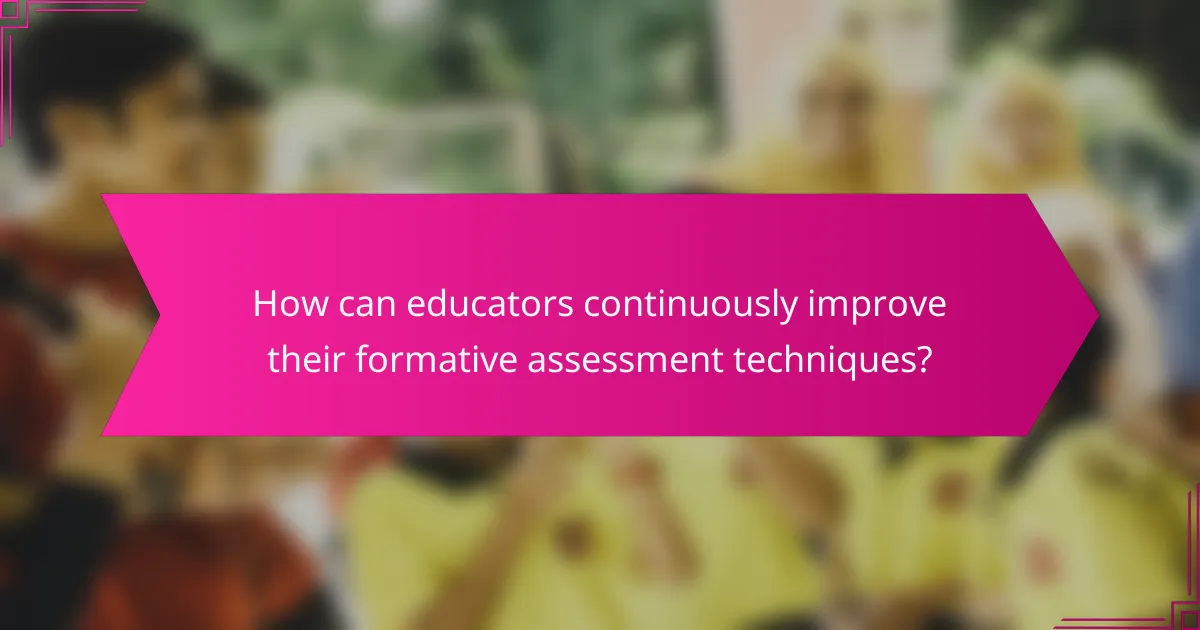
How can educators continuously improve their formative assessment techniques?
Educators can continuously improve their formative assessment techniques by regularly reflecting on their practices. They should analyze student performance data to identify areas needing enhancement. Incorporating student feedback can also provide insights into the effectiveness of assessments. Professional development workshops focused on assessment strategies can offer new techniques. Collaborating with colleagues fosters the sharing of best practices. Utilizing technology tools can streamline assessment processes and provide immediate feedback. Research shows that ongoing assessment adaptation leads to better student outcomes. For example, studies indicate that formative assessments can boost student engagement and understanding when refined consistently.
What resources are available for professional development in formative assessment?
Professional development resources for formative assessment include workshops, online courses, and instructional materials. Organizations like the Assessment Institute offer training sessions focused on effective assessment strategies. Additionally, the National Council of Teachers of Mathematics provides resources tailored to mathematics educators, which can be adapted for physics. Online platforms such as Coursera and edX feature courses on assessment practices in education. The book “Classroom Assessment Techniques” by Thomas A. Angelo and K. Patricia Cross serves as a comprehensive guide. Research from the American Educational Research Association highlights the positive impact of formative assessment on student learning outcomes. These resources support educators in implementing effective formative assessment techniques.
How can collaboration among educators enhance assessment practices?
Collaboration among educators can enhance assessment practices by fostering shared insights and diverse perspectives. When teachers work together, they can develop more comprehensive assessment tools. This collaboration leads to a better understanding of student needs and learning styles. Research shows that collaborative planning improves the quality of assessments. A study by Vescio et al. (2008) found that professional learning communities positively impact student achievement. Teachers can also align their assessments with curriculum standards through collaboration. This alignment ensures consistency in evaluating student performance. In addition, sharing best practices can lead to innovative assessment strategies. Ultimately, collaboration among educators results in more effective and equitable assessment practices.
What practical tips can educators use to implement formative assessment effectively?
Educators can implement formative assessment effectively by using a variety of strategies. First, they should provide timely feedback to students. This feedback helps students understand their learning progress. Next, educators can use diverse assessment methods. These methods include quizzes, peer assessments, and reflective journals. Incorporating technology can also enhance formative assessment. Tools like online quizzes provide instant feedback. Additionally, educators should encourage self-assessment among students. This practice promotes student ownership of learning. Regularly adjusting teaching strategies based on assessment results is crucial. This ensures that instruction meets students’ needs. Research shows that these practices improve student engagement and learning outcomes.
Formative assessment techniques in physics education are strategies designed to evaluate student understanding throughout the learning process. This article covers various methods such as quizzes, peer assessments, and concept maps, highlighting their role in providing immediate feedback to improve learning outcomes. It also distinguishes formative assessments from summative assessments, emphasizing their importance in enhancing student engagement and tailoring instruction to meet individual needs. Additionally, best practices for implementing these techniques effectively are discussed, along with the benefits of using technology and collaboration among educators to refine assessment practices.
